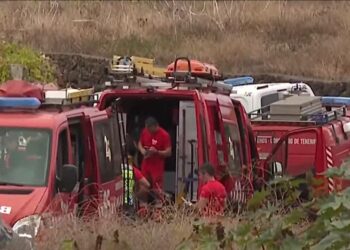The Government of the Canary Islands announced this Wednesday that the significant presence of pathogenic agents at Playa Jardín (Puerto de la Cruz), which led to its closure since July, is not attributable to the failure of the Punta Brava underwater outfall.
During a meeting of the monitoring commission held alongside the Cabildo of Tenerife and the City Council, the findings from the recent intensive sampling campaign conducted along the city’s coastline were presented.
In this regard, it was noted that out of the 60 analyses performed, only one — from Playa Chica — exceeded the acceptable limits. No other locations among the 15 tested displayed pathogen concentrations above the normal threshold.
Present at the meeting were Ángel Montañés, the general director of Ecological Transition and the Fight Against Climate Change; technical staff from the General Directorate of Public Health; Blanca Pérez, the Minister of Natural Environment, Sustainability, Security and Emergencies of the Cabildo; David Hernández, the councilor for Sustainable City of Puerto de la Cruz; and Javier Davara, the manager of the Tenerife Waters Island Council, along with technicians from the relevant administrations.
The coordination group resolved to prioritise and assist the Puerto de la Cruz City Council in executing sanitation measures in the Punta Brava area.
A total of 1 million euros will be allocated by the Cabildo of Tenerife, while the Department of Ecological Transition and Energy of the Government of the Canary Islands will contribute 300,000 euros in 2024 to fund part of the necessary works, which include connecting residents to the sanitation network and enhancing the existing system.
Moreover, ongoing works by the CIATF in the outfall will proceed, with efforts to secure authorisations for both the expansion and improvement of the La Orotava Valley Treatment Plant, as well as constructing the new outfall. The intensive analytical campaign will persist in the region, along with advancements in planning comprehensive sanitation upgrades for the municipality of Puerto de la Cruz.
During the meeting, updates on the work conducted by each party were shared, concluding that the elevated concentration of pathogenic agents in the area is not a result of the outfall’s rupture, as confirmed by recent analyses.
THE CALM SEA FACILITATES THE WORK
The Tenerife Island Water Council also provided updates on the repairs of the underwater outfall fissure, indicating that the favourable sea conditions have enabled work on the system for the evacuation of treated water at the Valle de La Orotava Purification Station, despite initial technical challenges.
Blanca Pérez, the Cabildo councillor, along with Javier Davara, the manager of the CIATF, stated that efforts are ongoing in the emissary to remove as much effluent as possible from the area surrounding the fissure.
David Hernández, the first deputy mayor and councillor of the Sustainable City of Puerto de la Cruz, reported that the municipality has organised meetings between various municipal departments involved in this issue and initial planning steps have commenced for enhancing the city’s sanitation system overall, especially in the Punta Brava neighbourhood.
Furthermore, the technical representatives of Public Health from the Government of the Canary Islands confirmed that current readings still prohibit swimming in this area of the Portuense coast.
















